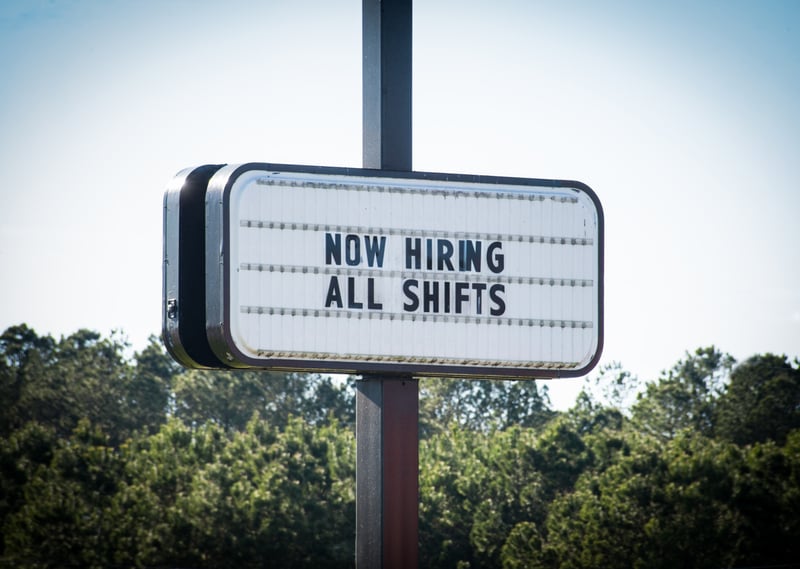
It was the best of times. It was the worst of times.
The decline of the pandemic and a return to some sense of normalcy brings with it many positives, but it also brings yet another new set of unprecedented challenges. The labor market is perhaps one of the most significant examples.
What is the “best”? The U.S. economy is finally experiencing the “V-shaped” recovery for which we have been waiting. The U.S. economy grew at a rate of 6.4% in the first quarter of 2021 and is expected to rise another 8.6% in the second quarter, as the combined impact of a mass vaccination rollout and federal stimulus checks triggered a surge in consumer spending. Between the Fed’s continued accommodative monetary policy and a fiscal stimulus from expected government spending on infrastructure and other programs, most economists are forecasting strong economic growth throughout 2021 and early 2022.
What then could possibly be the “worst”? Ask any HR professional, and they will tell you that recruiting has never been more difficult, even with 8 million more people unemployed than in pre-pandemic February 2020. As the following graphs indicate, Google searches for jobs have been trending down since mid-March, job ads are receiving fewer clicks, and job application rates have been declining.
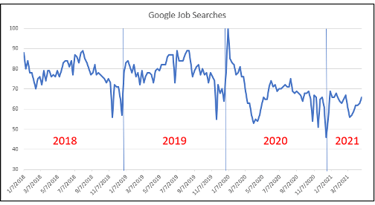
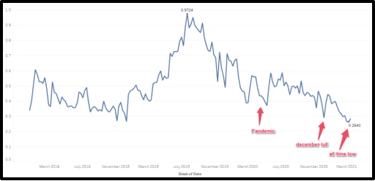
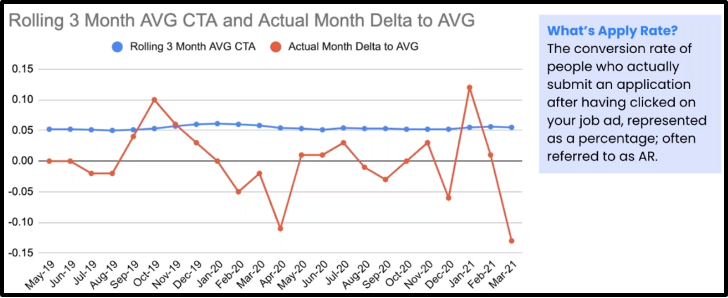 Sources: Google Trends, Appcast
Sources: Google Trends, Appcast
Why is this happening? Source2 sees three primary factors at play that are sidelining potential employees:
- Federal unemployment benefit of $300/week extended to September 3, 2021. The American Rescue Plan Act of 2021 (ARPA), passed in March 2021, created disincentives to work due to the extension of a $300 weekly federal unemployment benefit. State unemployment benefits typically cover between 45%-60% of lost wages. Combined with the additional federal unemployment (equivalent of $7.50 per hour), employers are struggling to attract candidates to jobs paying less than $18-$20 per hour.
- Fully subsidized COBRA coverage between April 1 and September 30, 2021. As part of the ARPA enactment, the Federal Government is providing a 100% subsidy of COBRA health care premiums. That means unemployed workers pay no share of premiums that would otherwise be required if employed and covered by an employer group plan.
- Slow pace of reopening of schools and childcare facilities. While this will self-correct with the continued rollout of vaccinations, the return to the workforce of parents of school-aged children has been hindered.
What now? States are taking action.
The $300 weekly federal unemployment benefit created by the passing of ARPA, which is officially named the Federal Pandemic Unemployment Compensation (FPUC), is administered through each state’s unemployment office. States can opt out of the program by providing 30-days’ notice.
In response to the data cited above, along with feedback from employers unable to fill open jobs, 23 states have announced termination of participation in the FPUC program. The following table shows the announcement dates and effective dates for terminations. A few states are also providing incentives to unemployed workers to accept jobs, and nearly all states are reactivating requirements that the unemployed actively seek work and provide proof to qualify for benefits.
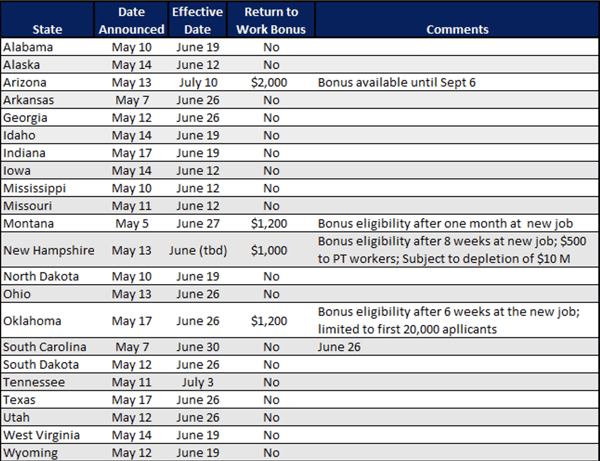
What does this mean for the months ahead? Be prepared for a hot summer of hot recruiting.
As the FUCA benefits end in many states throughout June and July, Source2 expects some improvement in job application rates. However, with the continued strong growth in job openings, the competition for employees will continue to be fierce. Success will depend on companies’ planning and strategic development of contemporary recruiting methods. Here are some suggestions:
- Dedicate a budget specifically to recruitment marketing if you haven’t already, and plan to increase your recruitment marketing spend in the coming months.
- Move beyond job posting with a “post & pray” mentality to a true omnichannel recruitment marketing strategy that leverages a mix of digital and traditional channels.
- Ensure a sufficient numbers of recruiters to engage quickly with candidates.
- Utilize technology, such as AI-driven text-to-apply, to cast a wider net and engage candidates quickly and simply in their preferred medium.
- Continually improve your recruiting brand image, including ratings on Glassdoor and Indeed.
With 20 years of experience, Source2 been assisting clients in making recruiting a source of competitive advantage. We are fast and highly flexible in customizing solutions to meet each client’s specific needs. We encourage pilot programs as a low risk and highly accelerated approach to getting started.
For more information, check out our website. If you would like to discuss your company’s specific situation and scaling solutions, connect with our executive team by emailing us at solutions@source2.com or by completing our contact form.
Tags:

May 25, 2021 3:57:23 PM
